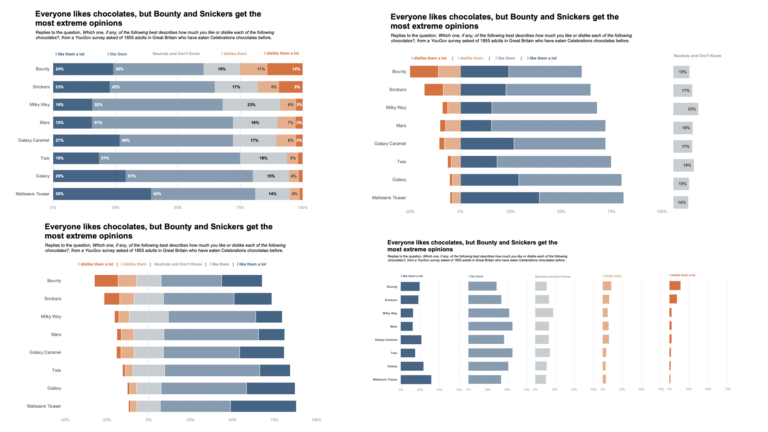Visualizing Survey Data
Working back to back on 3 survey visualization projects, I have come to realise that visualizing survey data can be pretty standard for the most part. Yes, every dataset from a survey will be different and insights will be different. But the ways in which we can visualize survey data can be more or less standardised. Hence this series of posts on Visualizing Survey Data.
Lets start with an understanding of the different types of survey questions.
What are the types of survey questions?
Survey questions that we come across in data visualizations, can be classified into 4 types.
Rating scale questions
Rating scale questions ask the respondents to asses a question based on a set of dimensions. Or simply put they are asked to choose a rating. There are 2 common rating scales, depending on the type of rating used.
- Likert type scales: Respondents are asked whether they agree or disagree with a statement. Each option of a likert scale can be given a score, which can later be used to analyse the results. These are commonly questions that have options like Strongly Agree, Agree, Neutral, Disagree, Strongly Disagree. Learn more about how to visualize Likert Scales.
- Semantic differential scale: In a semantic differential scale, each end of a scale is marked with opposing or differential statements. These are questions that look like “On a scale of 1 to 7, where 1 represents ‘not at all attentive’ and 7 represents ‘extremely attentive’ how attentive were our staff?“
Multiple choice questions
Multiple choice questions provide respondents multiple options to choose from. Here again there can be two types:
- Multiple choice single answer questions: These questions allow the respondent to choose a single answer. For example, the rating scale questions are a type of multiple choice single answer question.
- Multiple choice multiple answer questions: These questions allow the respondent to choose multiple answers.
Rank order questions
In rank order questions respondents must choose between multiple options and rank the options in sequential order.
An example of a rank order question would be “Rank these benefits in the order of most appealing to least appealing”
Branching questions
Though not very common, these questions carve out a specific path in the survey based on the answers to some questions. An example for a branching question may look like – “If you answered yes to question 8, answer question 10”
Over the course of next 4 weeks, we will see how to visualize each of these question types in detail.



